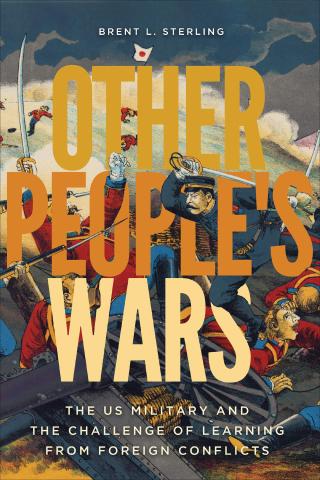The Strategy of Denial
Elbridge A. Colby. New Haven, CT: Yale University Press, 2021. 384 pp. Notes. Index. $32.50.
Reviewed by Commander Guy M. Snodgrass, U.S. Navy (Retired)
If someone asked for one book on contemporary defense strategy, Elbridge Colby’s The Strategy of Denial is the one I would recommend. The book is credible, timely, and extensive. Much of this undoubtedly stems from his deep scholarship and prior Pentagon experience.
As the Pentagon’s Deputy Assistant Secretary for Strategy and Force Development, Colby was responsible for the team that produced the 2018 National Defense Strategy. That firsthand experience shines through. He explains the ins and outs of crafting a strategy: Clearly defining its purpose, evaluating the current and desired geopolitical situation, assessing alliances and the roles they play, gauging the determination of adversaries and competitors, crafting a workable strategy given resource realities—it is all here, concisely written, and easily understandable.
What sets Colby’s book apart is its framing and deductive nature. Each chapter walks the reader down a path toward developing a contemporary defense strategy, providing longtime hands with new material, while also providing an excellent primer for those unaccustomed to strategies and their development. Colby also is to be commended for highlighting an area of extreme concern for the United States in the post-unipolar world: credibility. The next few years will be telling, as Russia once again looks poised to expand gains in Ukraine and China eyes Taiwan. The U.S. response in those situations will speak volumes to Colby’s determination that the United States should serve as a reliable keystone for antihegemonic alliances.
If there is a downside, it is that the book focuses predominantly on “denying China hegemony over Asia [as] the cardinal objective of American grand strategy.” This calls to mind a quote by Constantinos Markides, professor of strategic leadership at London Business School: “Designing a winning strategy is the art of asking questions, experimenting and then constantly renewing the thinking process by questioning the answers. No matter how good today’s strategy is, you must always keep reinventing it.” Yes, China is the most pressing concern, given its size, resources, and aggressive stance, but other nations can and will serve as spoilers, forcing the United States to consider its future through a wider aperture.
Put another way, a strategy begins to atrophy the moment the ink dries on its paper. Situations evolve, outside influences intervene, and—as the saying goes—the world gets a vote. During his time as Secretary of Defense, James Mattis stated that the situation that most concerned him would be a strong Russia-China alliance. It seems these two nations were listening.
Traditionally cold toward one another, in 2001 China and Russia signed the Sino-Russian Treaty of Friendship, a pact they recently renewed through 2026. Then there is the Shanghai Cooperation Organization, an intergovernmental group that counts Russia and India as member states. Fast forward to August 2021, when Russia and China conducted their first joint command-and-control exercise. Of this, the Chinese defense ministry said the joint exercise was designed to “further develop the China-Russia comprehensive strategic partnership in the new era, enhance the joint action capabilities of both parties and jointly maintain international and regional strategic stability.”
This was followed by an October 2021 joint transit of Chinese and Russian warships through the Tsugaru Strait, the narrow body of water separating Japan’s main island from its northern island of Hokkaido. The sortie was conducted to “maintain peace and stability in the Asia-Pacific region” and to “demonstrate the state flags of Russia and China,” according to the Russian defense ministry.
It seems that China is aware of the power of alliances and is seeking to challenge the United States at its own game.
When it comes to Colby’s book, the verdict is clear: It is an excellent and informative must-read for strategists and aspiring senior leaders. The verdict is less clear on his prescribed strategy. If history is a guide, China, Russia, and others still have a significant vote.
Commander Snodgrass previously served as a TOPGUN instructor, commanding officer for Strike Fighter Squadron 195 in Japan, speechwriter to then-Chief of Naval Operations Admiral Jonathan Greenert, and chief speechwriter for Secretary of Defense James Mattis. He is CEO at Defense Analytics and author of TOPGUN’s Top 10: Leadership Lessons from the Cockpit (Center Street, 2020).
Other People’s Wars
Brent L. Sterling. Washington, DC: Georgetown University Press, 2021. 321 pp. Maps. Biblio. Index. $39.95.
Reviewed by Lieutenant Commander Blake Herzinger, U.S. Navy Reserve
Anyone who has served in the modern U.S. military will be familiar with the idea of “lessons learned” in the context of internal after-action reviews. What Brent Sterling has done with Other People’s Wars is a fascinating treatment of U.S. efforts to draw lessons learned from foreign conflicts throughout history, but with a scholar’s critical eye toward what “lessons learned”
actually means.
Compiling U.S. experiences in observing and analyzing the Crimean War, the Russo-Japanese War, the Spanish Civil War, and the Yom Kippur War, Sterling offers nuance that is too often missed in traditional U.S. learning efforts. Rather than using the tired lessons learned, he delves into deeper analysis of those observations, differentiating between those that were merely remarked on and those that were applied. Perhaps most important, Sterling makes use of hindsight to examine why certain ideas were discarded, as well as how lessons were applied and whether the application was, in fact, warranted or beneficial.
If the modern military reader takes away one cautionary phrase from Sterling’s work, it might well be “beware of bias.” His well-chosen examples, beginning in the earliest days of U.S. efforts to observe foreign wars, highlight crucial opportunities throughout history that were missed simply because they did not align with the accepted wisdom of the day. Examples from ignoring the arrival of the machine gun to dismissing the need for bomber escorts or close air support might evoke some recognition of contemporary shifts, and accompanying resistance, toward concepts such as replacing manned fighters with uncrewed platforms or other such moves that challenge institutional equities and preferences.
As the Department of Defense (DoD) moves toward more data-driven assessment methodologies, Other People’s Wars would make a valuable addition to service and department reading lists and professional military education programs for its easily grasped treatment of issues such as confirmation bias and the need for replicable, verifiable measurement and assessment. Understanding these principles will be of increasing importance to leaders across DoD, from the tactical level to the strategic, and Sterling’s excellent historical account provides a series of compelling case studies and anecdotes from the past two centuries of military history.
Sterling’s methodology offers a multiplicity of categories for evaluating the learning efforts associated with the four conflicts in the book. While they are not unclear, they can be disorienting at times when attempting to determine their order or application. Each subcategory does not necessarily hold an example for each conflict; this does not detract from the book but is helpful to understand from the outset. Further, in terms of approaching the material with a complete understanding, the introduction is a must-read, and may warrant reading twice, before beginning the first chapter.
Other People’s Wars is not only interesting and well-written, but also arrives at a time when it is desperately needed. As the United States emerges from two decades of counterinsurgency and grapples with a return to thinking about conventional warfare against peer powers, this generation’s need for effective learning has arguably never been greater. Wars such as the 2021 clash between Armenia and Azerbaijan, the ongoing proxy conflict in Yemen, Russia’s seizure of Crimea, and the smoldering conflict in the Donbass region of Ukraine all are critical learning events for the U.S. military and its allies. Ensuring the right lessons are learned and applied in the right way will be essential in ensuring continued U.S. prosperity and maintaining the global order most favorable to U.S. interests.
Lieutenant Commander Herzinger supports Commander, Naval Forces Korea, and is a nonresident fellow at the Pacific Forum. His last active-duty assignment was as an intelligence officer based in Singapore, where he has spent the past eight years. In his civilian capacity he conducts security cooperation activities in support of the Indo-Pacific Maritime Security Initiative. He has been a Life Member of the Naval Institute since 2018.
Dying to Learn
Michael A. Hunzeker. Ithaca, NY: Cornell University Press, 2021. 190 pp. Notes. Index. $39.95.
Reviewed by Colonel Eric Reid, U.S. Marine Corps
With his first book, Michael Hunzeker makes a significant contribution to the historiography of war studies that is both deeply insightful and applicable to the current international security environment. Dying to Learn provides a fresh perspective on World War I to uncover and illuminate valuable lessons on three key factors of organizational structure that affect institutional learning and adaptation during war.
The text is clear and well-crafted throughout. After a thorough review of relevant secondary literature, Hunzeker leverages his own extensive archival research in three languages to examine pre–World War I organizational structures and warfighting doctrines of the German, British, and French armies. He then assesses the comparative performance of the armies in how effectively each learned lessons from unforeseen developments on the Western Front and how well each transmitted that learning to the trenches through development of new doctrine and training.
Dying to Learn provides an organizational theory to augment the overwhelming body of literature that tends to focus on organizational culture or the idiosyncrasies of key leaders. Hunzeker frames his argument around his assessment, command, and training (ACT) theory. His ACT theory predicts that three characteristics have the greatest impact on: the degree to which a military delegates battlefield command, the degree to which that military formally assesses its doctrine, and the degree to which a military standardizes training of its forces for combat. He then evaluates his theory by examining focused case studies of the German, British, and French armies in their common competitive environment. In the end, the book makes a compelling case that militaries are most successful in wartime adaptation when they afford moderate decentralization to battlefield commanders, have a formalized and prestigious assessment enterprise, and maintain tight control over standardization of training.
In the course of his analysis, Hunzeker rightly observes that great powers today are experiencing an interwar period similar in structure to that which preceded World War I in two key ways. First, the pace and character of technological change today resemble the global, dynamic, and technological advances at the dawn of the 20th century. Now as then, many current technological advances that will determine the character of the next great power war have been developed in the commercial sector. These technologies will combine within the cauldron of future conflict in ways that will most assuredly surprise us all.
Second, as with the historical period between the end of the Franco-Prussian war in 1871 and the outbreak of hostilities in August 1914, the world has not known great power military conflict for the past 76 years. No living statesman, politician, general, admiral, policy maker, or head of state has any personal experience with unconstrained interstate warfare. Everyone is learning vicariously and imagining an unpredictable future conflict.
Hunzeker advances scholarship on the role of organizational structures and incentives within military bureaucracies and their implications for competitive learning and adaptation during the most Darwinian of all environments: war. It is particularly promising as a serious professional military education resource in Newport, Quantico, and Carlisle. It belongs on bookshelves adjacent to Andrew Gordon’s Rules of the Game, Frank Hoffman’s Mars Adapting, and Williamson Murray’s Military Adaptation in War.
Colonel Reid is a career Marine infantry officer and is currently the G-5 at III Marine Expeditionary Force.
After the Apocalypse
Andrew Bacevich. New York: Metropolitan Books, Henry Holt and Company, 2021. 195 pp. $26.99.
Reviewed by Christopher Booth
In his latest jeremiad, After the Apocalypse, Andrew Bacevich throws a literary Molotov-cocktail at the U.S. political elite. He claims that 2020 represented the apocalypse in which the nation’s many ills came home to roost, ranging from military adventurism, profligate spending, environmental ruin, economic inequality, communal despair, and persistent racism at home (which he also diagnoses at the root of U.S. foreign policy).
Often, this broadside attack generates more heat than light, but Bacevich wields a blowtorch against the military-industrial complex as well as the bipartisan consensus of foreign policy mandarins. Bacevich admits that recent events are too close for a dispassionate assessment, and instead he intends After the Apocalypse to be an indictment. He also offers some prescriptive solutions.
Bacevich is a prolific provocateur, and at his best, in books such as America’s War for the Middle East: A Military History (2016), his willingness to challenge assumptions and accepted wisdom can provide a new way of looking at seemingly intractable problems—such as the U.S. government’s difficulties in navigating the Middle East from at least the Iranian Revolution in 1979, through the hostage crisis and Iran-Contra, Desert Storm, and of course the 2003 war in Iraq. It is that 2003 invasion, the fumbled intervention and 20-year struggle in Afghanistan, and the “Global War on Terror” that particularly animate Bacevich. He blames “the world’s preeminent military establishment” for its conduct of the wars in Iraq and Afghanistan, which he concludes were “indistinguishable from defeat.”
The history professor, West Point graduate, combat veteran, and retired Army colonel is probably on his strongest footing diagnosing missteps in military and foreign policy. Even so, his solutions are likely to engender strong responses from many readers. Examples include his suggestion that the United States critically reassess its relationship with Israel. He also argues that the U.S.-U.K. “special relationship” is a historical anomaly dating only from World War II, stating that prior to that time relations were frosty. He writes that close relations with a country America gained its freedom from through revolution is even “slightly weird” and the “fixation with the royal family,” nostalgia.
Many will be taken aback by his suggestion to withdraw from NATO in the next ten years and shutter U.S. Central and Africa Commands. Others may struggle with his recommendation to reduce the size of the Navy and concentrate instead on building out the Coast Guard. Bacevich’s most radical proposals are less straight forward, such as his argument that the social disparities that led to the growth of the Black Lives Matter movement should result in an “opportunity for a distinctly Black viewpoint to serve as the basis for future U.S. global policy.”
Never boring, After the Apocalypse is as abrasive and astringent as the homebrewed hooch that has fueled many a revolutionary Molotov. Anyone open to a revisionist interpretation of U.S. history and America’s role in the world may appreciate Bacevich’s effort. At a minimum, this quick and provocative read might inspire readers to reexamine some of their assumptions.
Mr. Booth is a career national security professional and served on active duty as a commissioned U.S. Army armor and cavalry officer. He has extensive experience abroad, including assignments in the Middle East, Asia, and Europe. He is a distinguished graduate of Command and Staff College-Marine Corps University. He graduated from Vanderbilt University Law School and received a bachelor’s degree from the College of William and Mary.









